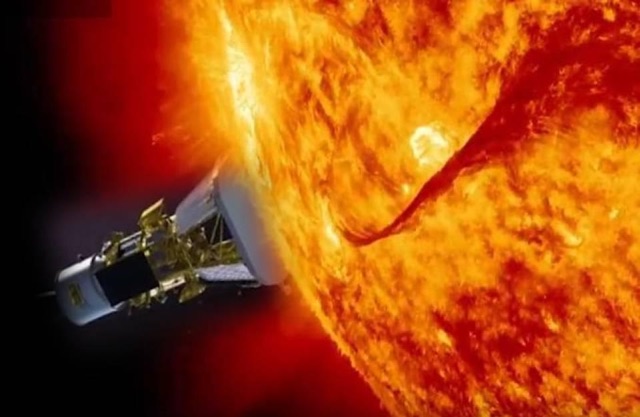
NASA shows off probe that will ‘touch the sun’ in 2018 in an attempt to predict devastating solar storms.
NASA has visited some awfully impressive places in the past 60 years, so it’s something of a wonder that the space agency hasn’t found its way to the sun by now. The New Horizons probe, which flew by Pluto in the summer of 2015, is now 3.5 billion miles (5.6 billion km) away; Voyager 1, launched in 1977, has left the solar system entirely, cruising through space at a remove of 11.7 billion miles (18.9 billion km) from Earth.
The sun, meantime, is within arms’ reach by cosmic standards, just 93 million miles (150 million km) away. And while it takes a lot of triangulating to get to Pluto, the sun is kind of hard to miss. Just point and shoot.
The problem of course, is that the sun is also — no surprise here — exceedingly hot. Temperatures in the corona — the blistering storm of plasma that stretches millions of miles into space and pops into view during a solar eclipse — approach 1 million degrees F (553,000° C). There’s a reason that the nearest any spacecraft has gotten to the solar inferno was 27 million miles (43 million km), a comparative close brush achieved by the Helios 2 spacecraft in 1976.
Now, however, NASA plans to get closer — a whole lot closer. At a press conference on May 31, NASA will officially announce the details and the launch date for the Solar Probe Plus spacecraft, a ship that will leave Earth next summer, sometime in a 20-day window from July 31 to Aug. 19, 2018.
There is a lot that makes the planned mission extraordinary. Its extremely close approach to the sun, a planned distance of 3.8 million miles (6.1 million km), will take it within the corona and mark the first time a human-built machine has ever technically touched a star. That contact will not just be a one-time thing. The spacecraft will go into an independent orbit of the sun in November of 2018, and will make up to 24 close approaches through June of 2025. Each orbit will take about 88 days to complete — the same as Mercury’s orbit of the sun — and at its peak speeds, the ship will be moving at 450,000 mph (724,000 k/h), or fast enough to get from Philadelphia to Washington, D.C. in one second.
That could mean a lot of thermal punishment for a spacecraft that will cost $1.5 billion to build, launch and operate and that carries four suites of sensitive instruments to measure electrical fields, magnetic fields, and electrons and heavy ions, plus a camera intended to return first-ever images from within the corona. Solar Probe Plus, however, is built for such off-road flying, with a 4.5-in. (114 mm) thick heat shield made of carbon composites. Behind that barrier, the instruments will operate at a comfortable room temperature.
There are a lot of important reasons to fly a mission so close to the sun, beyond at last planting NASA’s flag there — not that you could actually plant a flag on a body that, effectively, has no surface. For starters, scientists may at last get some answers as to why the million-degree coronasphere is up to 100 times hotter than the 10,000° F (5,500° C) surface, a mystery that has long puzzled them.
Much more significant to the taxpayers picking up the tab for the mission — and to everyone else on the planet, for that matter — is what the mission could reveal about the sun’s violent temperament. Solar storms — eruptions from the sun that send charged particles outward through the solar system — can disable communications satellites and potentially shut down electrical grids over vast swaths of the planet. One National Academy of Sciences study that NASA cites revealed that a particularly ferocious storm could cause up to $2 trillion in damage in the U.S. alone and black out the eastern seaboard for up to a year. A better understanding of what causes the eruptions might enable us to predict them — and protect ourselves in advance. That could make even a mission with a billion-plus price tag one of NASA’s great bargains.














How exactly are we going to protect ourselves from a massive eruption from the sun that is a direct hit to our electrical grid? Predicting a massive power failure is not going to eliminate a massive power failure. That money is better spent fixing an electrical grid that is one hack away (or in this case electrical storm) from being useless. We would be just as well off loading 1.5 billion in cash into a rocket and flying it into the Sun.